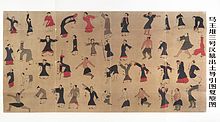Daoyin
| Daoyin | |
|---|---|
Hanyu Pinyin | dǎoyǐn |
| Yue: Cantonese | |
| Jyutping | dou6 jan5 |
Daoyin is a series of cognitive body and mind unity exercises practiced as a form of
and middle road styles like Wuxingheqidao.The main goal of daoyin is to create flexibility of the mind, thereby creating harmony between internal and external environments, which relaxes, replenishes and rejuvenates the body, developing in its practitioners a vital and healthy spirit.[citation needed]
In the West, daoyin is sometimes mistakenly equated with "daoist yoga" or "yin yoga" as "dao" (導) and "yin" (引) are mistakenly read as 'Dao' (道), as in "Daoism", and 'Yin' (阴), as in "Yin-Yang".[citation needed]
The Daoyin Tu


A painted scroll on display at the
The images include men and women, young and old. Their postures and movements differ from one another. Some are sitting, some are standing, and still others are practicing Daoyintu or exercising using apparatuses.
Translation of the texts covering the document show that the early Chinese were aware of the need for both preventive and corrective breathing exercises. The exercises can be divided into three categories:
- Postures of bodily exercises such as stretching arms and legs, leaning over, hopping, dancing, breathing exercises and using various equipment such as a stick and a ball.
- Imitating animal behaviour such as dragon, monkey, bear and crane.
- Exercises targeted at specific diseases.[5]
Effects
A typical daoyin exercise will involve movement of the arms and body in time with controlled inhalation and exhalation. Each exercise is designed with a different goal in mind, for example calmative effects or expanded lung capacity.
Some of the exercises act as a means of sedating, some as a stimulant or a tonification, whilst others help in the activation, harnessing and cultivation of internal Ch'i energy and the external Li life force. Through the excellent health that is gained thereby, they all assist in the opening up of the whole body, enhance the functioning of the autonomic nervous system, increase the mental capacity of the brain, give greater mind control, increase perception and intuition, uplift moral standards, and give tranquillity to the mind, which in turn confers inner harmony and greater happiness. As time goes by, these exercises slowly open up the functional and control channels that feed and activate the energy, nervous and psychic centres, enabling the individual to have a deeper understanding, consciousness and awareness of the spiritual world.[6]
According to Mantak Chia the practice of daoyin has the following effects: harmonization of the qi, relaxation of the abdominal muscles and the diaphragm, training of the "second brain" in the lower abdomen, improvement of health and structural alignment.[7]
See also
- Chinese alchemy
- Dantian
- Huangdi Neijing
- Internal alchemy
- Jing
- Lee-style tai chi
- Qigong
- Silk reeling
- Taoist philosophy
- Wudang Mountains
- Yangsheng (Daoism)
- Yin Yoga
- Yinshu
- Zhang Sanfeng
References
- ^ Taoist Ways of Healing by Chee Soo. Chapter 11 "Tao Yin - Taoist Respiration Therapy". p. 113. Aquarian Press/Thorsons - HarperCollins, 1986.
- ^ ISBN 0-944558-00-3.
- ISBN 0-415-00228-1.
- ISSN 0730-1049.
- ^ "Hunan Provincial Museum". Archived from the original on 2016-07-16. Retrieved 2017-03-12.
- ^ Taoist Ways of Healing by Chee Soo chapter 11 Tao Yin - Taoist Respiration Therapy page 114(Aquarian Press/Thorsons - HarperCollins 1986
- ISBN 159477059X.
8. Smith, Ronald and Carmone, Antonio (2022), Shadows of Mawangdui Animating the Daoyintu, Three Pines Press, ISBN 9781931483704
External links
- Entry on Daoyin from the Center for Daoist Studies
- The origin of Daoyin Inscription from a Warring State Period cultural relic - neigong.net
- Theory of essence Qi and spirit - neigong.net
- Entry on Tao Yin at the Seahorse Mediawiki Archived 2018-01-09 at the Wayback Machine
- 马王堆汉墓陈列全景数字展厅—湖湖南省博物馆 (Virtual tour of the Mawangdui Han Tombs exhibit at the Hunan Provincial Museum).

